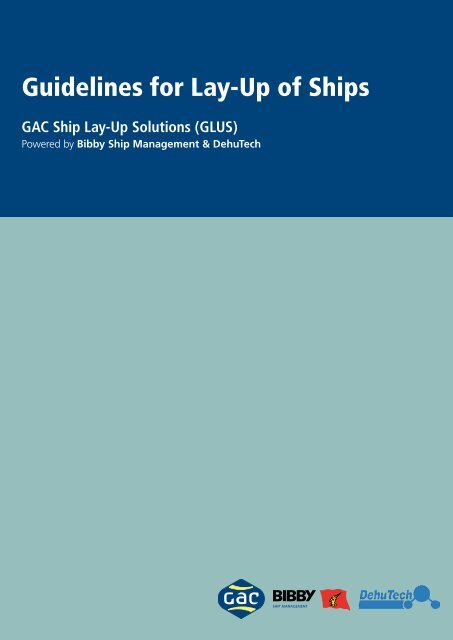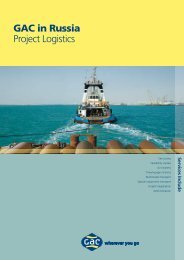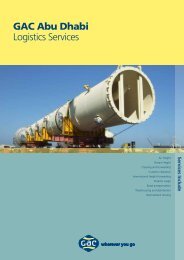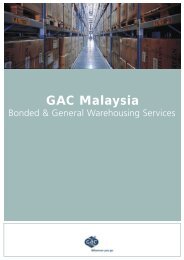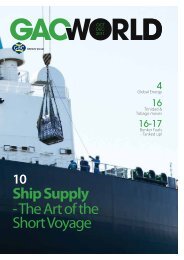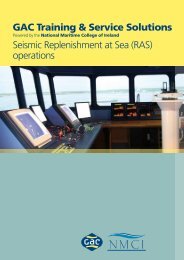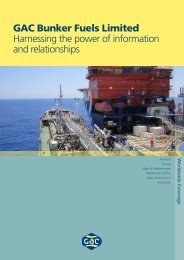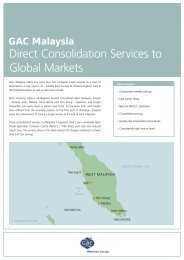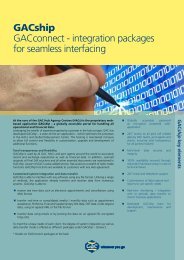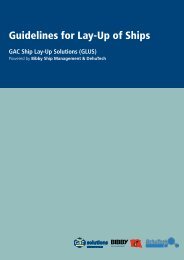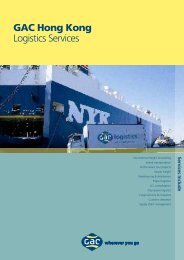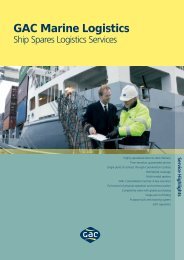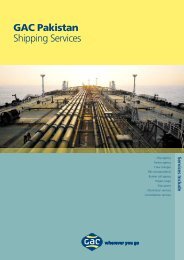Ship Lay-Up Guidelines - GAC
Ship Lay-Up Guidelines - GAC
Ship Lay-Up Guidelines - GAC
Create successful ePaper yourself
Turn your PDF publications into a flip-book with our unique Google optimized e-Paper software.
<strong>Guidelines</strong> for <strong>Lay</strong>-<strong>Up</strong> of <strong>Ship</strong>s<br />
<strong>GAC</strong> <strong>Ship</strong> <strong>Lay</strong>-<strong>Up</strong> Solutions (GLUS)<br />
Powered by Bibby <strong>Ship</strong> Management & DehuTech
<strong>GAC</strong> <strong>Ship</strong> <strong>Lay</strong>-<strong>Up</strong> Solutions<br />
Powered by Bibby <strong>Ship</strong> Management & DehuTech<br />
Index<br />
n Introduction P4<br />
n GLUS Set-<strong>Up</strong> and Partners P4<br />
n GLUS <strong>Lay</strong>-<strong>Up</strong> Sites P5<br />
n Class and Certification P8<br />
n Protection and Indemnity (P&I) P8<br />
n Hull and Machinery (H&M) Insurance P8<br />
n <strong>Lay</strong>-<strong>Up</strong> Options P9<br />
n Preparation for <strong>Lay</strong>-<strong>Up</strong> P10<br />
n Preservation and Maintenance P12<br />
n Underwater Services P18<br />
n Documentation and Record Keeping P19<br />
n Safety and Security P20<br />
n Crewing and Inspections P21<br />
n <strong>GAC</strong> Marine Logistics P22<br />
n <strong>GAC</strong> <strong>Ship</strong> Agency P23<br />
n Re-Commissioning and Start-<strong>Up</strong> P23<br />
3
<strong>GAC</strong> <strong>Ship</strong> <strong>Lay</strong>-<strong>Up</strong> Solutions<br />
Powered by Bibby <strong>Ship</strong> Management & DehuTech<br />
Introduction<br />
<strong>Lay</strong>ing-up ships makes good business sense during tough times. Not only does it allow ship owners and operators to avoid non-profitable<br />
journeys and over supply, it also reduces wear and tear, crew costs, fuel consumption and insurance premiums during the idle period.<br />
<strong>GAC</strong> <strong>Ship</strong> <strong>Lay</strong>-<strong>Up</strong> Services (GLUS) has prepared these guidelines as support for customers that opt to lay-up their vessels – whether it be<br />
for shorter or longer periods – and to provide a clear overview of the lay-up methods and services available.<br />
GLUS Set-<strong>Up</strong> and Partners<br />
<strong>GAC</strong> <strong>Ship</strong> <strong>Lay</strong>-<strong>Up</strong> Solutions (GLUS) works with “best in class” partners under a single umbrella to provide the broad range of skills and<br />
experience required for the comprehensive care of a ship being laid-up.<br />
Part of the <strong>GAC</strong> Solutions stable, GLUS is a strategic partnership with Bibby <strong>Ship</strong> Management Ltd and DehuTech AB. It aims to assist<br />
customers at a range of lay-up locations around the world with a range of services and products including: identification of lay-up<br />
locations, ship agency, logistics support, technical management, crewing, dehumidification, surveillance and preparation for reactivation.<br />
<strong>GAC</strong> Solutions<br />
<strong>GAC</strong> <strong>Ship</strong> <strong>Lay</strong>-<strong>Up</strong> Solutions – Powered by Bibby <strong>Ship</strong> Management and DehuTech is a unit under <strong>GAC</strong> Solutions, a special business area of<br />
the <strong>GAC</strong> Group, set up to provide value-added products to the shipping and marine industries. It combines <strong>GAC</strong>’s knowledge and long<br />
standing relationships with its shipping, logistics and marine customers with the products from world-leading suppliers. Other services<br />
range from class-approved fire, rescue & safety systems / services, onboard and office based weather routing solutions, protective<br />
solutions (anti-piracy), workwear and the list is growing.<br />
Bibby <strong>Ship</strong> Management<br />
Bibby <strong>Ship</strong> Management’s dedication to quality brings economic advantages to its clients. In particular, the company’s adherence to<br />
stringent quality management systems, industry foresight and professional integrity means that the long term interests of clients are<br />
prioritised. Bibby <strong>Ship</strong> Management has a global presence and is part of Bibby Line Group, with over 200 years of marine heritage.<br />
DehuTech AB<br />
DehuTech is a Swedish company that exports desiccant dehumidifiers to countries outside Sweden. The dehumidifiers are developed,<br />
designed and manufactured in Sweden and are used for a vast number of different industrial applications. DehuTech AB is a subsidiary<br />
of Fuktontroll AB, Sweden which has been active in the domestic Swedish market since 1980.<br />
4<br />
<strong>GAC</strong> <strong>Ship</strong>- <strong>Lay</strong>-<strong>Up</strong><br />
Solutions helps safekeep<br />
your business with<br />
our comprehensive range<br />
of services delivered by<br />
professionals.
<strong>GAC</strong> <strong>Ship</strong> <strong>Lay</strong>-<strong>Up</strong> Solutions<br />
Powered by Bibby <strong>Ship</strong> Management & DehuTech<br />
GLUS <strong>Lay</strong>-<strong>Up</strong> Sites<br />
Thanks to the <strong>GAC</strong> Group’s global network of offices and agencies, <strong>GAC</strong> <strong>Ship</strong> <strong>Lay</strong>-<strong>Up</strong> Solutions has the local experience, expertise and<br />
resources to offer informed advice on the best lay-up locations, as well as a wide range of secure, safe and cost-effective solutions for<br />
vessels laying-up wherever you go, including:<br />
n Australia<br />
n Malaysia<br />
n Sri Lanka<br />
n Thailand<br />
Norway<br />
Sweden<br />
United Kingdom<br />
Poland<br />
United States Greece<br />
Dubai<br />
China<br />
Trinidad<br />
Thailand Vietnam<br />
Philippines<br />
Sir Lanka<br />
Malaysia<br />
n Vietnam<br />
n Philippines<br />
n China<br />
n Dubai<br />
5<br />
n Greecen<br />
n Poland<br />
n Sweden<br />
n Norway<br />
Australia<br />
n United Kingdom<br />
n United States<br />
n Trinidad
<strong>GAC</strong> <strong>Ship</strong> <strong>Lay</strong>-<strong>Up</strong> Solutions<br />
Powered by Bibby <strong>Ship</strong> Management & DehuTech<br />
GLUS <strong>Lay</strong>-<strong>Up</strong> Sites<br />
Sites may differ widely, depending upon the type of vessel, so the following should be considered when choosing a suitable site:<br />
n Shelter provided from open seas, winds, waves, swells etc.<br />
n Mooring method including ships berthed alongside, at buoys, anchors, stern moorings, anchored rafts of several vessels, etc.<br />
n Security of location.<br />
n Proximity to preferred trading routes after reactivation.<br />
n Detailed local weather conditions, such as:<br />
wind, waves and swell, direction and force;<br />
cyclones, hurricanes, ice, local currents and tides;<br />
reliability of local weather forecasting services.<br />
n Shelter provided from open seas, winds, waves, swells etc.<br />
n Anchorage depth and type of holding ground, with diver or sonar surveys as appropriate.<br />
n Water depth to be sufficient for the vessel to remain afloat with sufficient under keel clearance at all tide conditions.<br />
n Proximity to any obstructions, wrecks, underwater cables or pipes, etc.<br />
n Proximity to passing traffic and other moored vessels.<br />
n Proximity of any commercial aquaculture including fish farms, oyster beds, water intakes etc.<br />
n Details of local authorities and availability of tugs, fire fighting, medical and safety services.<br />
n Availability of services such as fresh water, waste disposal, shore power and repairers<br />
n Available space or number of designated lay-up positions<br />
n Suitable access and egress channels, pilotage, tug assistance during mooring, etc.<br />
n Likely hull fouling due to marine growth<br />
n Location of any effluent or corrosive discharges<br />
n Availability of spare or replacement mooring equipment<br />
n Potential windage of vessels, containers on deck, etc.<br />
n Facilities for shore monitoring of vessel position, remote GPS monitoring etc.<br />
6
<strong>GAC</strong> <strong>Ship</strong> <strong>Lay</strong>-<strong>Up</strong> Solutions<br />
Powered by Bibby <strong>Ship</strong> Management & DehuTech<br />
GLUS <strong>Lay</strong>-<strong>Up</strong> Sites<br />
Approval of lay-up arrangements<br />
Approval by Flag State, Port State, harbour authorities, classification societies, hull & machinery insurers and their surveyors are handled<br />
by GLUS when making lay-up arrangements, tailor-made for each vessel and its location.<br />
Mooring arrangements<br />
Initial checks are made to ensure that the ship is safely positioned at its designated mooring. Mooring arrangements may vary depending<br />
upon the location, wind / sea conditions and local regulations. For example in fjords, ships are moored with anchors forward and wires<br />
to the shore aft. In sheltered bays they are laid together in rafts, bow to stern, with anchors at both ends. In some benign areas, they<br />
are laid on a running mooring with both anchors laid out. Vessels may also be laid up alongside a suitable berth.<br />
GLUS assesses specific requirements of each vessel and liaises with the local authorities to ensure the safest arrangements, taking into<br />
consideration the following:<br />
n The mooring must be sufficient to hold in the most extreme wind conditions.<br />
n Assessment of water depth compared to vessel draft and freeboard.<br />
n Frequent anchor checks to ensure that anchors are well pulled in, and chains are as straight as possible and at optimum tension. If<br />
in doubt regarding anchor holding efficiency, the whole mooring operation is carried out again. Anchor positions should be marked<br />
with buoys to show locations and to facilitate recovery if slipped.<br />
n When wires are used astern, they must be under even tension and taut.<br />
n Position of anchor chains and mooring lines to be varied at regular intervals to prevent uneven wear at contact points with hawse<br />
pipes, fairleads, winches, etc.<br />
n If the vessel is laid up against a quay, suitable fenders and safe gangways with adequate lighting must be used.<br />
n To minimise windage and improve anchor holding, tankers should take about 30% deadweight ballast, and bulk carriers should have<br />
maximum ballast.<br />
n Except in special circumstances, mooring for lay-up on a single anchor is not considered unless the lay up is a very short “Hot” type.<br />
n Allowances are made for high profile vessels with a large side windage - such as car carriers, passenger/cruise ships and container<br />
vessels with container stacks - when assessing the strength of the mooring system.<br />
n To easily ascertain any change in draft, final lay-up draft marks forward and aft are marked conspicuously with white lines on port<br />
and starboard sides.<br />
n Depending on the location, emergency towing lines should be deployed fore and aft, ready for use, without adjustment, in case the<br />
vessel needs to be towed off the berth or anchorage.<br />
n Multiple vessels are laid up together, either alongside or in anchored or moored groups or ‘rafts’, should be of a similar size.<br />
n Vessels alongside should normally be not more than three abreast and all facing in the same direction.<br />
n When moored in rafts, vessels should normally not be more than six abreast, anchored to face in alternate directions and secured<br />
bow to stern.<br />
7
<strong>GAC</strong> <strong>Ship</strong> <strong>Lay</strong>-<strong>Up</strong> Solutions<br />
Powered by Bibby <strong>Ship</strong> Management & DehuTech<br />
Class and Certification<br />
Class Certification<br />
Flag, Class and Insurance requirements<br />
Laid-up ships are subject to all relevant national, port and other statutory requirements. These may vary extensively depending upon the<br />
lay-up location as well as the Flag and Class of vessel.<br />
Period of Class<br />
Depending on the vessel’s Classification, its class period may continue unchanged throughout the lay-up period. In such cases, periodical<br />
surveys will be performed, although dry-dock surveys that fall due while the ship is laid-up may be deferred until reactivation.<br />
Class renewal<br />
Where the class of a vessel has expired, renewal is conditional on the performance of a substitute survey. Special surveys are designed<br />
and set up for laid-up vessels.<br />
Safety certificate<br />
<strong>Ship</strong>’s equipment is subjected to inspections required for the issue of a safety equipment certificate.<br />
Depending on the period of lay-up, Flag States or recognised organisations acting on behalf of Flag States may suspend or withdraw<br />
certificates required under International Safety Management (ISM) Code and International <strong>Ship</strong> and Port Security (ISPS) Code.<br />
When the vessel is reactivated, appropriate surveys will be required before the certificates can be re-issued.<br />
Protection and Indemnity (P&I)<br />
The vessel’s P&I club must be advised of the intention to lay-up the vessel, and whether any crew will remain on board for the duration<br />
of the lay-up period.<br />
Hull and Machinery (H&M) Insurance<br />
H&M insurers must be advised of the intention to lay up the vessel and their approval obtained of the lay-up site. Insurers’ requirements<br />
must be complied with. Relevant documentation, including insurance agreements and certificates, should be available and a folio of<br />
documents maintained throughout the lay-up period.<br />
8<br />
All insurance<br />
documentation must be<br />
readily available through<br />
the lay-up period.
<strong>GAC</strong> <strong>Ship</strong> <strong>Lay</strong>-<strong>Up</strong> Solutions<br />
Powered by Bibby <strong>Ship</strong> Management & DehuTech<br />
<strong>Lay</strong>-<strong>Up</strong> Options<br />
<strong>Lay</strong>ing-up a ship is designed to:<br />
n maintain the security, safety and protection of the vessel, crew and environment;<br />
n preserve and maintain the vessel structure and machinery by protecting against<br />
corrosion and static seizure.<br />
The extent to which a vessel will be laid-up depends on several factors, including:<br />
anticipated lay-up period duration; the need to reduce running costs; time required for<br />
reactivation; and the age and value of the ship.<br />
GLUS offers four different modes of lay-up:<br />
n Hot up to 3 months (H)<br />
n Warm up to 12 months (W)<br />
n Cold uo to 5 years (C)<br />
n Long term 5 plus years (L)<br />
9<br />
Modes of <strong>Lay</strong>-<strong>Up</strong>s:<br />
Hot 1-3 mths (H)<br />
Warm 4-12 mths (W)<br />
Cold 1-5 years (C)<br />
Long Term -5 years (L)<br />
Hot lay-up (24-hour reactivation)<br />
This lay-up condition is suitable for up to a month out of service. In this condition, the vessel is held within Classification and Flag State<br />
requirements, although crew numbers may be reduced to certified minimum safety crewing limits. Machinery is kept operational but<br />
economies are made. The vessel is located in an area close to potential cargo trade routes.<br />
Warm lay-up (one-week reactivation)<br />
Suitable for up to 12 months out of service. In this condition, vessel crewing is reduced to below the trading limit and in agreement with<br />
the Flag State, Classification Society, insurers and local authorities. Most ports will only grant a temporary permit to lay-up a vessel in<br />
this condition in port, provided that Class and Flag surveys are conducted. There may be local restrictions on vessels operations such as<br />
restrictions on the transfer of oily bilge water.<br />
Cold lay-up (three-week reactivation)<br />
Suitable for up to five years out of service. In this condition, vessel crewing is in line with emergency requirements to deal with fire,<br />
flooding, mooring and security watch. Cold ship lay-up locations are generally remote so access to the vessel can be limited. <strong>Up</strong>on<br />
reactivation, the vessel may need to go direct to dry dock before trading, depending on the extent of any hull marine growth. It is<br />
imperative that all preparations and processes during cold lay-up are well documented as crew changes may be significant.<br />
Long-term lay-up (three-month reactivation)<br />
Suitable for up to more than five years out of service. In this extended condition, preparations are comprehensive as original manufacturers<br />
are consulted for critical equipment, Any remedial work done on reactivation is likely to be extensive and unpredictable, such as renewal<br />
of alarm systems that may have become obsolete. For long-term lay-ups, several vessel are laid up side-by-side to minimise supervision<br />
costs.<br />
GLUS is aware of all these potential problems involved in lay-ups and has the experience, expertise and resources to avoid the pitfalls.
<strong>GAC</strong> <strong>Ship</strong> <strong>Lay</strong>-<strong>Up</strong> Solutions<br />
Powered by Bibby <strong>Ship</strong> Management & DehuTech<br />
Preparation for <strong>Lay</strong>-<strong>Up</strong><br />
General<br />
To ensure that the ship may be re-commissioned without delay if required, any necessary<br />
repairs or servicing should be performed prior to lay-up. This requires close liaison with<br />
the vessel owners to reach agreement sought on what work need to be carried out before<br />
lay-up. When machinery is shut down, the following should remain ready for use.<br />
Safety equipment<br />
n All safety equipment must be in good working order and fully tested prior to lay-up.<br />
The amount of safety equipment onboard may be reduced in certain circumstances,<br />
such as removal of BA escape sets that would normally be used by substantive crew<br />
and which are not required onboard during lay-up.<br />
n Lighting, fire fighting and lifesaving equipment must be maintained in operational<br />
condition during lay-up. Depending upon available power sources, lighting may have<br />
to be run from a portable generator placed onboard.<br />
n All consumables and flammable material must be removed prior to lay-up, including<br />
chemicals, paint, gases.<br />
Security<br />
To ensure security during the lay-up period the Company Security Officer in co-operation<br />
with the <strong>Ship</strong>’s Security Officer must arrange security measures and procedures with the<br />
administration responsible for the lay-up facility.<br />
Safety management<br />
GLUS, through Bibby <strong>Ship</strong> Management, prepares all the respective procedures for the<br />
laid-up operation mode, to ensure satisfactory control. All respective documentation<br />
containing emergency procedures and means of communication, must be on board the<br />
vessel.<br />
Fire alarm and fire-fighting systems<br />
n The onboard fire alarm system must remain operative during lay-up. Where no fire<br />
alarm system is installed on board and provision is not made for a permanent watch,<br />
a temporary fire alarm system should be fitted in the engine room and other relevant<br />
spaces.<br />
n The electricity supply must be sufficient to enable a one-main fire pump to be<br />
operated.<br />
n The emergency fire pump should be kept ready for use and the fire-fighting system<br />
should be tested at weekly intervals.<br />
n Fire hoses, equipment items, international shore connections and other fire fighting<br />
appliances such as hand extinguishers or CO2 systems must be kept ready for use at<br />
all times.<br />
n Readily ignitable articles which increase the risk of fire should be removed. Bilges<br />
should be dried and kept free from oil. Where there is a risk of frost, fire mains are<br />
to be drained.<br />
10<br />
Onboard fire alarm and<br />
fire-fighting systems<br />
must remain operative<br />
during lay-up.
<strong>GAC</strong> <strong>Ship</strong> <strong>Lay</strong>-<strong>Up</strong> Solutions<br />
Powered by Bibby <strong>Ship</strong> Management & DehuTech<br />
Preparation for <strong>Lay</strong>-<strong>Up</strong><br />
The following GLUS activities generally apply to “Cold” and “Long-Term” <strong>Lay</strong>ups,<br />
but in some circumstances may also apply to the “Hot” or “Warm” <strong>Lay</strong>-up<br />
modes.<br />
General criteria for lay-up:<br />
n Apertures / inspection openings where covers have been removed for air circulation<br />
should be covered with fine mesh wire gauze to prevent ingress of foreign matter.<br />
n External equipment moved to dehumidified spaces should be properly stowed, the<br />
storage location carefully recorded and the normal location site labelled.<br />
n All machinery and equipment components removed from their normal location should<br />
be properly labelled and stowed adjacent to the parent unit within dehumidified<br />
spaces. The parent unit should be marked with appropriate labels indicating the<br />
location of such components.<br />
n Fuel oil lines should be isolated, and injectors removed, cleaned, coated with oil and<br />
stowed.<br />
n Internal combustion engine cylinders must be lubricated with lube oil while engine is<br />
turned by hand.<br />
n Cooling systems should be drained of water and left open to dehumidified atmosphere.<br />
Where neoprene sealing rings are fitted, system should be left charged to prevent dryout<br />
and corrosion inhibitors added.<br />
n Sea water systems should be drained and opened to dehumidified atmosphere.<br />
n Selected inspection covers should be removed to allow free circulation of dry air<br />
throughout the machine.<br />
n Exhaust lines should be blanked.<br />
n Underwater areas must be adequately protected with sacrificial anodes and hull<br />
potential to a satisfactory level.<br />
n During lay-up, ballast tanks should be maintained either full or empty. Full tanks<br />
may be protected by means of corrosion inhibitors or sacrificial anodes. Empty tanks<br />
should be dried out to minimise corrosion. All sludge and mud should be removed<br />
prior to lay-up.<br />
n All sea valves should be fitted with internal blank flanges. External sea suctions should<br />
be closed off by divers using fibreglass blanks fitted with neoprene seals. Blanks<br />
should have a pocket to allow a biocide brick to be inserted to prevent marine growth<br />
in the grids.<br />
n The stern seal should be checked externally by divers to ensure there are no ropes or<br />
lines penetrating the seal assembly that could result in leakage.<br />
n Safe access to the vessel must be provided for watchmen and maintenance crews.<br />
11<br />
Special preparation is required<br />
before a vessel can be laid up.
<strong>GAC</strong> <strong>Ship</strong> <strong>Lay</strong>-<strong>Up</strong> Solutions<br />
Powered by Bibby <strong>Ship</strong> Management & DehuTech<br />
Preservation and Maintenance<br />
The nature and extent of preservation required for each laid-up vessel is determined by:<br />
n lay-up duration.<br />
n lay-up location and corresponding climatic conditions.<br />
n general condition of the vessel (to be assessed and corrective maintenance performed in liaison with the owners prior to lay-up).<br />
n conditions governing re-commissioning.<br />
Corrosion is a major problem when laying-up a vessel and all measures should be made to reduce and even eradicate the risk. Any<br />
measures taken must be recorded for reference as a check list when the ship is re-commissioned. The following methods are used to<br />
reduce corrosion:<br />
n Total and effective sealing of major accommodation and machinery spaces from external atmospheric conditions, particularly where<br />
high humidity levels exist.<br />
n Controlled dehumidification of internal air spaces (including void spaces within machinery and pipelines) to prevent sweating and<br />
humidity corrosion damage, as well as moisture absorption into electrical cables and fittings.<br />
n Application of preservatives and suitable lubricants to external equipment and machinery not within the dehumidified spaces.<br />
n Hull cathodic protection to be maintained, and for long term lay-up ballast tanks to be suitably protected. This could mean that they<br />
are totally emptied, cleaned and dried out or fully ballasted to remove air pockets and corrosion inhibitor added.<br />
n Regular turning of rotating machinery to prevent corrosion damage to bearings, seizure and component distortion. Equipment would<br />
be identified and highlighted on the check lists for this purpose.<br />
Controlled humidity space sealing and dehumidification<br />
Humidity can present risks for laid-up vessels. Corrosion and other moisture damage can be costly and cause serious delays when the time<br />
comes to re-activate. GLUS provides a range of dehumidifying services to reduce the risk of such damage.<br />
The atmosphere within designated spaces should be kept within certain set limits to ensure preservation of equipment. In some<br />
geographical location or during certain seasons, some may consider this to be unnecessary. However, this is a fallacy and dehumidification<br />
requirements should never be underestimated.<br />
Main Machinery spaces should be maintained at 30 – 50% RH<br />
Accommodation spaces should be maintained at 45 – 55% RH<br />
All openings – including doors, windows, port holes, vent/extraction apertures, sanitary outlets, scuppers, drains and air intake grids –<br />
should be secured and sealed using proven methods. Limited means of access to be retained.<br />
Dehumidification units of adequate capacity need to be sited and installed, together with associated distribution trunking to achieve<br />
sufficient air circulation both within the ‘controlled’ spaces as a whole and through major individual items of machinery, equipment<br />
and systems within those spaces. The circulation of dry air will be arranged such that desired levels of relative humidity will be achieved<br />
throughout. All water / steam systems and tanks within the controlled spaces, except those required for the lay-up operation will be<br />
drained free of water (including bilge areas), dried and left open to dehumidified atmosphere. Non-return valve internals will be removed<br />
where necessary to improve air circulation within the systems.<br />
12
<strong>GAC</strong> <strong>Ship</strong> <strong>Lay</strong>-<strong>Up</strong> Solutions<br />
Powered by Bibby <strong>Ship</strong> Management & DehuTech<br />
Preservation and Maintenance<br />
Dehumidifiers<br />
DehuTech AB, <strong>GAC</strong>’s strategic partner in GLUS, develops, designs and manufactures<br />
dehumidifiers and can provide a range of services to reduce the risk of such humidity<br />
damages.<br />
Dehumidifiers are used for different areas onboard, including:<br />
n Accommodation areas.<br />
n Engine rooms.<br />
n Bridge and control rooms.<br />
n Specific objects.<br />
There are basically two types of dehumidifiers:<br />
n Condensing dehumidifiers.<br />
n Desiccant dehumidifiers.<br />
For laid-up ships, desiccant dehumidifiers are most widely used. However, in certain<br />
climates and for certain compartments, condensing dehumidifiers could also be used.<br />
13<br />
Desiccant dehumidifier<br />
n The air that should be dehumidified (process air)<br />
enters the rotor. The water molecules are absorbed<br />
in the silica gel rotor.<br />
n The rotor is reactivated through another air stream<br />
which is heated to 80-100 ºC. The moisture leaves<br />
as warm, wet air.<br />
Dehumidifiers are either installed outside the area to be dehumidified with ducts or hoses for dry air - sometimes also processing air<br />
connected to the dry space - or inside the dehumidified area. Desiccant dehumidifiers also have ducts for wet air and, sometimes,<br />
reactivation air to the exterior. For specific objects, such as the crankcase of an engine, dry air is introduced to the interior in a socalled<br />
“open system”.<br />
Dehumidifiers are normally installed indoors or outdoors with separate weather<br />
protection. Specially designed outdoor dehumidifiers that do not need any separate<br />
weather protection are also available.<br />
Desiccant dehumidifiers may be installed in ambient temperatures from -30°C to +40°C,<br />
while condensing type dehumidifiers are restricted to use in medium or high ambient<br />
temperatures. In tropical climates, a dehumidifier must be protected against radiated heat<br />
from the sun.<br />
A dehumidifier can either be in continuous operation or controlled by humidistat to a<br />
desired level of relative humidity.<br />
Monitoring and recording of relative humidity can either be done using simple instruments<br />
for visual reading, or with more sophisticated digital instruments which can in some cases<br />
with the option to connect to a remote computer.<br />
For laid-up ships, the principle of installation must be decided for each and every compartment or object to be dehumidified,<br />
taking into consideration many different parameters such as the desired level of relative humidity (RH) and climatic conditions at the<br />
mooring place. The type and size of each dehumidifier must also be determined and several other practical questions resolved.<br />
GLUS has the experience, expertise and resources to provide informed advice on the best option for each individual laid-up vessel.
<strong>GAC</strong> <strong>Ship</strong> <strong>Lay</strong>-<strong>Up</strong> Solutions<br />
Powered by Bibby <strong>Ship</strong> Management & DehuTech<br />
Preservation and Maintenance<br />
Diesel engines<br />
Engines that have been run on heavy fuel oil should operate on diesel fuel for a sufficient time before shut down to ensure that the fuel<br />
lines and the injection system are free from heavy fuel oil.<br />
Engine shut-down up to 3 months<br />
Preservation measures are usually unnecessary for shut-down periods of up to 3 months. Only during cold times of the year is it<br />
necessary either to keep the engine room temperature above freezing point or add antifreeze to the fresh cooling water. The mixing<br />
ratio depends on anticipated temperatures and should be determined in accordance with manufacturer’s instructions. Lubricating oil<br />
should be subjected to thorough separation. The moisture content must not exceed a maximum limit of 0.1%. Any decision regarding<br />
the further use of old oil should be preceded by an analysis.<br />
Approximately every two weeks, the engine should be lubricated and turned through at least two revolutions, taking care to ensure<br />
that on each occasion the crankshaft comes to rest in a different position. Where engines are fitted with cylinder lubricators, it is<br />
recommended that these should also be turned by hand during the rotation of the engine. After turning, the indicator cocks should be<br />
re-closed.<br />
Engine shut-down for longer periods<br />
Protection of the combustion chambers and fuel injection systems<br />
The following preservation procedure should be applied in the interests of internal protection: A mixture of gas oil and 20% by volume<br />
anti-corrosion oil should be fed into the fuel system. While the engine is running at reduced revolutions with an increased lubricating<br />
oil pressure, the air intake apertures should be closed, causing the engine to come to a stop without ignition. Another possibility is to<br />
use an atomiser to spray in anti-corrosion oil through the openings in the combustion chamber (injection valve or inspection parts). The<br />
compatibility of the anti-corrosion oil with the circulating oil is to be confirmed by the manufacturers.<br />
Engine casing<br />
For smaller engine casings it is recommended that the crankcase vents and all apertures provided on the engine are sealed to prevent any<br />
air. Information about the condition of the oil can also be obtained by analysis. The limit values specified by the engine manufacturers<br />
must not be exceeded. Where an oil change has been carried out, the engine should have run with the new oil for at least 15 minutes.<br />
If the shut-down period exceeds 6 months, the oil filter and casing require special attention. They should be cleaned and filled with<br />
anticorrosion oil.<br />
The engine entablature of large engines must be ventilated. Relative humidity of no more than 35% should be maintained. This can<br />
be achieved by means of an air-drier. According to type, air-driers with a closed circuit (air recycled to the drier) or an open circuit (air<br />
discharged into the engine room) may be used. Care must be taken to ensure adequate air circulation in the engine casing. Where an<br />
air-drier is also used to keep the engine room dry, separate ventilation of the engine casing is essential. If closed circuit air-driers are used<br />
in the engine room, all apertures are to be closed. Gears, camshaft and all control elements should be protected with anticorrosion oil.<br />
Turbocharger and exhaust line uptakes<br />
The exhaust line outlet should be sealed. Drain cocks should be opened. Ideally, in the engine room, air should be able to circulate<br />
inside the exhaust line, with the air outlet located as close as possible to the end to the exhaust line. The turbocharger intake filters must<br />
be cleaned and protected according to their design requirements. Internal parts of the turbocharger should also be protected against<br />
corrosion. The rotor should be arrested and all openings closed. Charging air coolers should be drained. Attachments made of materials<br />
which are not resistant to seawater must be protected.<br />
General - Cooling water spaces<br />
Anticorrosion oil should be added to the fresh cooling water before lay-up. After the ship has been taken out of service, fresh water<br />
systems should be drained. Where complete drainage is not feasible; antifreeze should be added prior to shut-down. Confirmation<br />
should be obtained from the manufactures that the anticorrosion oil and the antifreeze are compatible with each other and with other<br />
cooling water additives as well as with seals and hoses.<br />
Starting air system<br />
The entire starting air system, including air cylinders, should be protected and depressurised wherever possible. Air cylinders should<br />
be opened. Pneumatic control systems should also be depressurised. All drainage devices should be left open. The condition of the<br />
protection must be checked regularly.<br />
14
<strong>GAC</strong> <strong>Ship</strong> <strong>Lay</strong>-<strong>Up</strong> Solutions<br />
Powered by Bibby <strong>Ship</strong> Management & DehuTech<br />
Preservation and Maintenance<br />
Boilers (measures for combustion gas spaces)<br />
Boilers run on heavy fuel oil should be changed over to diesel oil prior to shut-down. The fuel piping system should be free from heavy<br />
fuel oil completely.<br />
The boiler should be cleaned on the furnace side of all soot and combustion residues which can absorb moisture and lead to corrosion.<br />
Any defects, such as leakages, must be repaired. After cleaning, the boiler should be dried by heating (for example, by briefly firing the<br />
burner(s) on diesel oil).<br />
Exposed external parts of the boiler should be protected as necessary. Exhaust pipes are to be covered and protected from the elements.<br />
Silica gel should be placed within the furnace to maintain a dry atmosphere. To maintain dry air within the boiler, dried air may be<br />
circulated within a closed cycle around the furnace / tubes and uptakes. Alternatively, dried air may be passed through an open circuit<br />
with the exhaust air leaving the top of the boiler and directed back into the engine room.<br />
Seawater cooling systems<br />
Seawater systems which are not in operation should be drained. It is advisable to flush out lines and heat exchangers with fresh water<br />
and then dry. All drain cocks should be left open. Valve spindles should be tested from time to time to ensure that they can move freely.<br />
As far as possible, all bottom and shipside valves should be closed. Valve spindles should be greased.<br />
It must be remembered that systems or parts of systems may be opened for he purposes of preservation. All strainers should be drained,<br />
mopped dry and left open together with selected valves, thus permitting the circulation of dry air.<br />
Fresh water cooling systems<br />
Fresh water cooling systems should be drained and dried. All drain cocks should be left open. Expansion tanks should be cleaned and<br />
protected. Interiors should be drained and dried out. Inspection covers and drain plugs should be removed for air circulation, and suction<br />
strainers drained and left open.<br />
Refrigerating equipment<br />
Before refrigerating plant is shut down, care must be taken to ensure that there are no leaks in the coolant circuit. Coolant should be<br />
drawn off into the condenser or collector. Condensers should be opened on the water side and dried. Refrigerating spaces should be<br />
ventilated.<br />
Deck machinery<br />
Deck machinery should be regularly activated and should, wherever possible, be preserved internally and externally and covered over.<br />
Where the laying-up conditions make this necessary, anchor and mooring winches should be kept ready for use. Steam-powered winches<br />
may, if necessary, be operated by compressed air, and in this case at least one air receiver of appropriate size should be held in readiness.<br />
Air compressors and systems<br />
Lube oil should be drained from sumps whilst warm, system recharged with clean oil and the machine run for 5 minutes before final shutdown.<br />
Unless the compressor is required for use during lay-up routines, covers and valves on all stages should be removed and cylinders<br />
lubricated. Air filters and inspection covers should be removed and header drains left open to allow free circulation of air. Receivers<br />
should be drained and mopped dry and drains and inspection doors left open.<br />
Fuel oil purifiers<br />
Internals should be removed, cleaned, coated with grease and stowed. Bowl and crankcase should be left open to atmosphere. The<br />
crankcase should be drained, cleaned and charged with new oil of owners’ supply.<br />
Steering gear<br />
The entire steering gear should be subjected to a service test once a week. Provision should be made for the adequate lubrication of the<br />
rudder carrier bearings. Exposed parts must be protected.<br />
Bilge level alarms<br />
The bilge level alarm system should be kept operative. Where such a system is not installed, a temporary alarm system should be fitted.<br />
Valves in seawater systems which are not in operation should be closed. The bilge pump should be kept ready for use.<br />
15
<strong>GAC</strong> <strong>Ship</strong> <strong>Lay</strong>-<strong>Up</strong> Solutions<br />
Powered by Bibby <strong>Ship</strong> Management & DehuTech<br />
Preservation and Maintenance<br />
Accommodation<br />
If the vessel is laid-up unmanned:<br />
n In addition to external sealing arrangements described in controlled humidity space sealing and dehumidification, all sanitary fittings<br />
should have openings sealed and water supply systems isolated.<br />
n All provisions stores and dry stores should be emptied, cleaned and doors secured in open position.<br />
n All cabin linen should be stowed in a central locker in clean condition, mattresses stood on edge and all cupboard and cabin doors<br />
secured in open position.<br />
n All access alleyway decks should covered with H/D polythene. If carpets are fitted these should be cleaned then covered with a<br />
breathable fabric for protection.<br />
n All navigation and communication systems should be isolated (except local VHF Trans/receiver) and room doors left open to ensure<br />
good air circulation.<br />
n Accommodation spaces should be sprayed with insecticide to prevent infestations of cockroaches, etc.<br />
Electrical Installation & Equipment<br />
n All electrical equipment and cables must be in good condition, particularly those required during lay-up such as engine room and<br />
accommodation lighting systems and main auxiliary switchboards. Electrical power may be provided by a portable diesel generator<br />
or shore power when available. This will minimise utilisation of the vessel’s own emergency generator which can then be laid-up.<br />
Temporary cables should be supplied and safely installed as necessary.<br />
n Lead batteries should be regularly recharged. Automatic chargers should be kept in operation. The acid level of batteries must be<br />
checked every month.<br />
n Electric motors and generators should be heated; low-voltage heating via the windings is recommended. Small motors, switch boxes,<br />
electronics cabinets and switchboards should be kept dry and, where necessary, sealed using moisture absorbent materials.<br />
n Full insulation tests should be carried out on all distribution systems and motors prior to lay-up, and readings recorded and submitted<br />
to owner on a regular basis.<br />
n The condition of external motors should be monitored by taking regular insulation readings. If the condition deteriorates to a point<br />
where it would be detrimental to the motor, where possible, it should be removed and stowed in a dehumidified area.<br />
n All starters, control panels and distribution boards within dehumidified spaces, where safe to do so, should have access doors<br />
partially opened to allow free circulation of dry air.<br />
Main Boilers<br />
n Gas side<br />
Boilers run on heavy fuel oil should be converted to diesel oil prior to shut-down. Steps should be taken to ensure that the entire<br />
fuel piping system is free from heavy fuel oil. The shut-down boiler should be cleaned on the furnace side and any leaks repaired.<br />
After cleaning, the boiler should be dried by firing briefly with diesel oil. Exposed external parts of the boiler are to be protected<br />
as necessary. Accumulations of soot and dust should be removed. Exhaust pipes should be covered. The furnace may be kept dry<br />
with silica gel. Another possibility, as in preservation method III applied to turbines, is to introduce dried air into the boiler furnace<br />
and recycle it to the drier in a closed circuit.<br />
In the case of auxiliary and exhaust gas boilers, the dried air may be passed through an open circuit with the exhaust air leaving<br />
the top of the boiler and directed back in to the engine room.<br />
Water Space – Dry protection<br />
Dry conditions may only be maintained in steam generators if they can be completely drained. Preferably, the boiler should<br />
be drained and opened while hot. To dry thoroughly, pipes, corners, recesses, receivers, etc. should be scavenged with<br />
compressed air. The drying operation may be performed much more effectively if the water space is evacuated. Silica gel is<br />
then suspended at suitably distributed points to absorb the moisture in the boiler. For boilers with natural water circulation<br />
a rough guide is of silica gel per tonne of boiler capacity. Silica gel and other drying agents are preferable to calcium<br />
chloride as they can be regenerated by heat. After the moisture absorbent has been placed inside, the boiler should to be<br />
sealed. The condition of the drying agent should be checked after about 14 days. The target relative humidity should be<br />
about 30%. Nitrogen offers another means of protection. Nitrogen is introduced at the highest point of the dried boiler.<br />
By maintaining a slight excess pressure and replenishing automatically during the period protection, oxygen in the air is<br />
prevented from re-entering.<br />
16
<strong>GAC</strong> <strong>Ship</strong> <strong>Lay</strong>-<strong>Up</strong> Solutions<br />
Powered by Bibby <strong>Ship</strong> Management & DehuTech<br />
Preservation and Maintenance<br />
Water space - Wet protection<br />
This method is to be preferred to other means of protection, particularly where the boiler is soon to be returned to service.<br />
Where there is a danger of sub-zero temperatures, suitable counter-measures are required. Oxygen in the air can be<br />
prevented from penetrating by a blanket of nitrogen at an excess pressure of about 0.1bar.<br />
Steam lines which may be filled with water as part of the wet protection procedure should be suitably secured to take the<br />
additional weight, i.e. anchoring spans and providing supports where necessary. The treatment of the boiler water should<br />
be agreed with the boiler manufacturer and the chemical supplier, as appropriate.<br />
Stern tube, tail shaft and engine shafting<br />
The level in the stern tube oil top tank should be checked. Where pressure feed lubrication is used, the pumps shall be operated at a<br />
regular intervals. Additional lubrication should be supplied to the intermediate shaft bearing to prevent wear when the equipment is<br />
turned, for example in the form of molybdenum sulphite as dry lubricant.<br />
External equipment<br />
All moving and working parts of deck fittings should be proved free and thoroughly coated with preservative grease. Crane cabs should<br />
be secured and sealed and control positions covered and secured.<br />
Arrangements should be made for the regular turning of steam / hydraulic deck machinery on air. Engine interioris and all working parts<br />
should be regularly lubricated. Lifeboats and davits must be kept in good working order, regularly lowered and the engines run on test.<br />
Cranes<br />
At least one stores crane should be in good working order for use during the lay-up period, and have valid load test certificates issued.<br />
Stores and provisions<br />
All excess or unnecessary equipment, stores and provisions should be off-loaded, particularly in long term lay-up situations.<br />
17
<strong>GAC</strong> <strong>Ship</strong> <strong>Lay</strong>-<strong>Up</strong> Solutions<br />
Powered by Bibby <strong>Ship</strong> Management & DehuTech<br />
Underwater Services<br />
GLUS can provide a range of specialist underwater maintenance, servicing and repair work on vessels as lay-up starts, throughout the<br />
lay-up period and at reactivation, including:<br />
Hull cleaning<br />
Ongoing research and development of new-generation hull cleaning equipment ensures understanding of how to successfully clean the<br />
latest low surface energy coatings currently in service.<br />
Propeller polishing<br />
A propeller-polishing tool can produce an industry standard surface finish of 0.5µ Ra. The cost of a quality underwater polish represents<br />
only a small proportion of the fuel savings it achieves.<br />
Worldwide inwater surveys<br />
Major Classification Approval ensure equipment is optimised to match the prevailing underwater conditions by using CCTV and high<br />
resolution cameras that are sensitive to low light levels. GLUS can also provide CAD generated drawings.<br />
Other services include<br />
Afloat Shell Plating Repairs<br />
Allowing defective areas of shell plating beneath the waterline to be cut out and replacement insert plates be welded into position whilst<br />
the vessel is afloat.<br />
Afloat Stern Seal Repairs<br />
Capabilities to provide underwater stern seal replacement and repair services strategically situated at key global sites.<br />
Afloat Propeller Repairs<br />
Technically sophisticated solutions to propeller damage and associated performance problems in cooperation with Subsea Propeller<br />
Incorporated (SPI).<br />
Underwater Welding Typical Applications<br />
Sacrificial and impressed anode replacement, Rope guard and rudder repairs, External doubler plates, Sealing up disused inlet and outlet.<br />
Specific services that may be required before, during and after lay-up include the following:<br />
At <strong>Lay</strong>-<strong>Up</strong> commencement<br />
n In-water inspection of underwater hull and fittings prior to lay-up, with particular attention to the condition of the coating and the<br />
sacrificial anodes;<br />
n Reinstatement of coatings underwater, such as epoxy anticorrosive coatings and (if required) tin free underwater applicable antifouling;<br />
n Replacement of depleted sacrificial anodes and attachment of additional of sacrificial anodes for protection during lay-up (essential<br />
if impressed current systems are to be switched off).<br />
n Design, manufacture and fitting of pressure blanks to sealing sea chest openings and discharge pipes while ship side valves are<br />
inspected internally, repaired or replaced. These pressure blanks are a sandwich of aluminium and marine plywood and thus<br />
unsuitable for long-term immersion. Information from ship’s drawings or a detailed inspection by divers is required to ensure the<br />
correct fit on the hull.<br />
n For long-term lay-ups, removal of valves to prevent corrosion and isolation of internal pipe work from sea water by fitting temporary<br />
steel spade blanks. Valve removal relieves the need for movement of the valves at regular intervals. Removal of valves and sealing<br />
the hull opening also removes the flooding risk where manhole doors are removed from salt water cooled coolers and equipment<br />
within the engine room;<br />
n Fitting of lay-up sea chest covers to seal the sea chest against water flow and sunlight to limit fouling growth within the sealed sea<br />
chest. A capped port can be fitted for injection of biocide to kill off any existing fouling inside the sea chest, but full local permission<br />
is required before using biocides. Covers would not be applied to fire pump sea chests as they must be kept operational throughout<br />
lay-up.<br />
18
<strong>GAC</strong> <strong>Ship</strong> <strong>Lay</strong>-<strong>Up</strong> Solutions<br />
Powered by Bibby <strong>Ship</strong> Management & DehuTech<br />
Underwater Services<br />
During <strong>Lay</strong>-<strong>Up</strong><br />
n Periodic underwater inspections in line with class or owner requirements to monitor the hull condition and rectify emergent work;<br />
n Monitoring of oil leakage and temporary sealing arrangements made where leakage found;<br />
n Monitoring of bow and stern thrusters for leakage, as well as removal for repair ashore and reinstatement prior to re-commission;<br />
n Regular hull cleaning. Vessels with biocide free low energy antifouling hull coating will foul rapidly while stationary. Unchecked, this<br />
may permanently damage;<br />
n Sealing of emergent leakage problems caused by hull corrosion;<br />
n Fitting pressure blanks to sea valves to allow repair and replacement;<br />
n Underwater inspection of mooring / anchoring systems;<br />
n Full Class inspection surveys, if required, depending on lay-up duration;<br />
n Periodic checks on the hull electrical potential along the underwater side area to assess the effectiveness of the anode hull protection<br />
system.<br />
Reactivation<br />
n Hull cleaning prior to vessel leaving under her own power or being towed to a dry dock/breakers’ yard;<br />
n Removal of sea chest covers;<br />
n Cleaning of fouling choked sea chests;<br />
n Application of pressure blanks for reinstatement or inspection of hull side valves;<br />
n Inspection of rudders and stabilisers prior to and during re-commissioning of the systems to ensure correct operation and<br />
rectification of any defects;<br />
n Propeller polishing to remove fouling and calcareous deposits and peak efficiency of the propulsion system once the vessel gets<br />
under way;<br />
n Underwater inspection by competent diver, as required by Class if lay-up period is more than 12 months.<br />
Documentation and Record Keeping<br />
All work carried out during lay-up preparation must be carefully recorded, documented and photographed. Copies of records should<br />
be retained on board (or ashore in designated office) during the lay-up period for use during reactivation. Any spares or equipment<br />
subsequently removed for operational purposes, such as transfer to other operational vessels, must be duly recorded. A daily routines log<br />
book must be kept to record all activities carried out by the lay-up team.<br />
19
<strong>GAC</strong> <strong>Ship</strong> <strong>Lay</strong>-<strong>Up</strong> Solutions<br />
Powered by Bibby <strong>Ship</strong> Management & DehuTech<br />
Safety and Security<br />
Safety, security and protective measures are essential for laid-up vessels, and they vary<br />
according to the type and location of the lay-up.<br />
Hot/Warm lay-ups:<br />
While crew numbers may be reduced from the normal full operational complement during<br />
hot lay-ups, there must be sufficient manpower onboard at all times – including qualified<br />
officers and crew – to maintain the vessel in a safe and secure position. Stand-by crew /<br />
watchmen are required to maintain a full-time fire, leakage, mooring, safety and security<br />
watch of the vessel.<br />
Cold/long-term lay-ups:<br />
For cold lay-ups, alarm functions must be in place including independently powered fire<br />
and flooding alarms. If these cannot be run from the vessel’s main system, temporary<br />
systems may need to be fitted to cover machinery space, bilges and other spaces as<br />
deemed appropriate. These services include:<br />
n Fire fighting capability sustained through either the emergency fore pump or retrofitted<br />
equipment.<br />
n Removal of all unnecessary flammable material as well as gas freeing and cleaning of<br />
various tanks /compartments.<br />
n Arrangements for the safe containment and frequent removal of garbage and sewage<br />
produced by crew or watch personnel onboard.<br />
n Suitable evacuation facilities of watchmen living onboard, to include either gangways<br />
or lifeboats / rafts, and evacuation equipment such as breathing apparatus and<br />
associated equipment.<br />
n Sealing of all air intake and exhaust openings not required to protect compartments<br />
and machinery, such as the generator and main engine uptakes funnel exhausts.<br />
n Onboard security by limiting access by boarding, securing and sealing of doors to the<br />
accommodation and other spaces. Provision of suitable alarm systems with remote<br />
monitoring.<br />
n Provision of a safe working environment for onboard crew, watchmen and maintenance<br />
workers.<br />
n Minimisation of the risk of air pollution.<br />
n Enclosed spaces to have the facility to be ventilated prior to entry (in the cold lay-ups,<br />
this takes the form of portable blowers rather than the vessel’s own equipment).<br />
n Oil tanks to be drained of fuel oil, then cleaned and maintained in gas-free condition<br />
and tested at regular intervals. Oil pipelines, including main engine pressure pipes, to<br />
be drained and cleaned prior to long term lay-up.<br />
20<br />
Safety, security and protective<br />
measures are essential during a<br />
vessel’s laid-up period.
<strong>GAC</strong> <strong>Ship</strong> <strong>Lay</strong>-<strong>Up</strong> Solutions<br />
Powered by Bibby <strong>Ship</strong> Management & DehuTech<br />
Crewing and Inspections<br />
GLUS provides sufficient manpower to carry out the lay-up preparation, with the assistance<br />
of the existing crew. After initial lay-up has been achieved, then as soon as possible the<br />
crew can be reduced until the vessel is finally de-manned or reduced to an agreed level.<br />
If unmanned, GLUS provides watchmen to ensure the security for the vessel, and staff<br />
to carry out maintenance routines. Reductions below minimum crewing levels should be<br />
agreed with the relevant Flag State and any necessary dispensation obtained. GLUS can<br />
carry these discussions on behalf of the owner as required.<br />
For all lay-ups – hot, warm, cold or long-term – an inspection regime must be established<br />
onboard. Most lay-up locations requirement the maintenance of a skeleton crew either<br />
onboard or at a shore-based located close to the vessel.<br />
The <strong>Lay</strong>-up team’s main objective is to conduct regular inspections of the vessel’s spaces,<br />
machinery and equipment through designed maintenance procedures recognised by<br />
makers of the equipment, and to ensure that the standard of preservation is maintained.<br />
Inspection regimes must be fully documented in advance of lay-up and may include daily,<br />
weekly, monthly and annual activities. Full procedures and necessary records must be<br />
maintained. Inspection routines should be specific to the vessel type and the machinery<br />
onboard, and is drawn up after consultation with the owners.<br />
GLUS conducts the following checks as a minimum:<br />
n Regular checks of operation of emergency equipment apparatus, fire, leakage, and security systems and alarms (see Safety and<br />
Secuirity)<br />
n Visual checks on ‘controlled’ space sealing arrangements being fed the dehumidified air supply. This will include regular measurement<br />
checks on relative humidity levels within these ‘controlled’ spaces<br />
n Visual checks on protective coatings which have been applied to all external machinery and equipment. It may be necessary to<br />
increase the protective coatings depending upon the fabric condition at the time of lay-up<br />
n Periodic visual examination of all opened machinery and equipment within dehumidified spaces.<br />
n Visual checks on all ‘filled’ systems for leaks, such as hydraulics, fuel, lubrication oil, air conditioning and water. This includes oil sump<br />
levels where it has been necessary to maintain oil levels.<br />
n Visual and measurement checks of battery systems.<br />
n Live test of emergency fire pump and system - a prerequisite in most lay-up locations.<br />
n Measurement checks of electrical circuit insulation continuity.<br />
n Visual regular checks on all occupied storage tank levels.<br />
n Periodic underwater survey by qualified diving contractor.<br />
n Measurement checks on hull potential (cathodic protection system)<br />
n Frequent checks on communication systems. This will necessitate keeping a power supply to the equipment, probably via the vessels<br />
emergency batteries or a portable emergency power supply.<br />
21<br />
Even during lay-ups, appropriate<br />
crewing levels must be<br />
maintained.
<strong>GAC</strong> <strong>Ship</strong> <strong>Lay</strong>-<strong>Up</strong> Solutions<br />
Powered by Bibby <strong>Ship</strong> Management & DehuTech<br />
<strong>GAC</strong> Marine Logistics<br />
<strong>GAC</strong> Marine Logistics (GML) is a specialised logistics service which covers the entire<br />
supply chain management of ship spares and marine parts. It aims to provide ship owners,<br />
ship management companies, ship builders and manufacturers with an integrated and<br />
seamless end-to-end solution which is time and cost efficient – even during times of ship<br />
lay-ups, emergency or crisis.<br />
The GML service operates in conjunction with GLUS by offering logistics services which<br />
cover demobilization of equipment from vessels entering lay up periods. Whether that<br />
involves local storage, re export, transfer to other vessels in the fleet or local delivery,<br />
GML provides the logistics solutions as an integral part of <strong>GAC</strong>’s innovative service to the<br />
shipping industry.<br />
How you benefit<br />
n Highly specialised door-to-deck delivery service for ship spares and marine parts,<br />
ensuring cost and time efficiency<br />
n Worldwide coverage<br />
n Special focus on landed items otherwise known as reverse logistics<br />
n 24/7 operation<br />
n Full control of physical operation and communication throughout supply chain<br />
n Single point of contact<br />
n Competitive rates by leveraging global buying power<br />
n Purpose designed web tracking system<br />
22<br />
<strong>GAC</strong> Marine Logistics offers timedefinite,<br />
door-to-deck delivery of<br />
ship spares worldwide
<strong>GAC</strong> <strong>Ship</strong> <strong>Lay</strong>-<strong>Up</strong> Solutions<br />
Powered by Bibby <strong>Ship</strong> Management & DehuTech<br />
<strong>GAC</strong> <strong>Ship</strong> Agency<br />
Through its global ships agency network, <strong>GAC</strong> has identified a range of locations around the world suitable for laying up ships. Thanks<br />
to decades of extended relations, <strong>GAC</strong>’s local offices maintain excellent rapport with port authorities to ensure that your vessels,<br />
superintendents, officers and crew get the best possible support at all times for your cleared in, laid-up and/or cleared out ships. Years of<br />
experience at most locations means clients can benefit directly from <strong>GAC</strong>’s considerable tacit knowledge and buying power.<br />
<strong>GAC</strong>’s Hub in Dubai acts as the main focal point for <strong>Ship</strong> <strong>Lay</strong>-<strong>Up</strong>s, providing you with a single convenient point of contact for quotations<br />
and invoices, and enabling you to deal with best-in-class agents, logistics providers, technical managers, dehumidification manufacturers<br />
and other specialists for specific detailed matters. That centralised coordination means that the <strong>GAC</strong> team dealing with your laid-up<br />
vessels is always synchronised and well placed to provide you with the best possible advice.<br />
For lay-ups, <strong>GAC</strong>’s specialist have created a comprehensive list of information required from each client, enabling <strong>GAC</strong> to identify the<br />
specific needs and best solutions for every individual vessel to be laid-up.<br />
Re-Comissioning and Start-<strong>Up</strong><br />
When a vessel is re-commissioned, any outstanding surveys must be performed together with a full check of the entire machinery<br />
installation. Depending on the duration of the lay-up, a trial that may be performed after consultation with the respective Classification<br />
society. A reactivation or complete audit of the vessel’s Safety Management System must also be performed, depending on how long<br />
the vessel has been inactive.<br />
Disclaimer:<br />
Every effort has been made to ensure the accuracy of the information contained in these guidelines to laying-up ships. However, any use of<br />
these guidelines are at the recipient’s own risk and the <strong>GAC</strong> Group, <strong>GAC</strong> <strong>Ship</strong> <strong>Lay</strong>-<strong>Up</strong> Solutions, Bibby <strong>Ship</strong> Management Ltd and DehuTech<br />
AB nor the employees thereof accept any liability for the up-to-date nature, accuracy, completeness or quality of information provided<br />
herein. Any claim of liability arising out of or in connection with material or non-material loss as a result of reliance on the information or<br />
advice contained in this document is excluded unless such loss or damage is caused by the proven wilful misconduct or grossly negligence of<br />
<strong>GAC</strong> <strong>Ship</strong> <strong>Lay</strong>-<strong>Up</strong> Solutions. All offers are subject to alteration and are non-binding. <strong>GAC</strong> <strong>Ship</strong> <strong>Lay</strong>-<strong>Up</strong> Solutions expressly reserves the right<br />
without notice to change, supplement or delete parts of the pages or the entire offer or to stop the publication temporarily or definitively.<br />
23
<strong>GAC</strong> <strong>Ship</strong> <strong>Lay</strong>-<strong>Up</strong> Solutions<br />
Powered by Bibby <strong>Ship</strong> Management & DehuTech<br />
(A unit of <strong>GAC</strong> Solutions Limited)<br />
PO Box 17041<br />
Jebel Ali, Dubai<br />
United Arab Emirates<br />
Tel +971 4 881 8090<br />
Fax +971 4 881 7037<br />
Email shiplayup@gacworld.com<br />
www.gacworld.com


